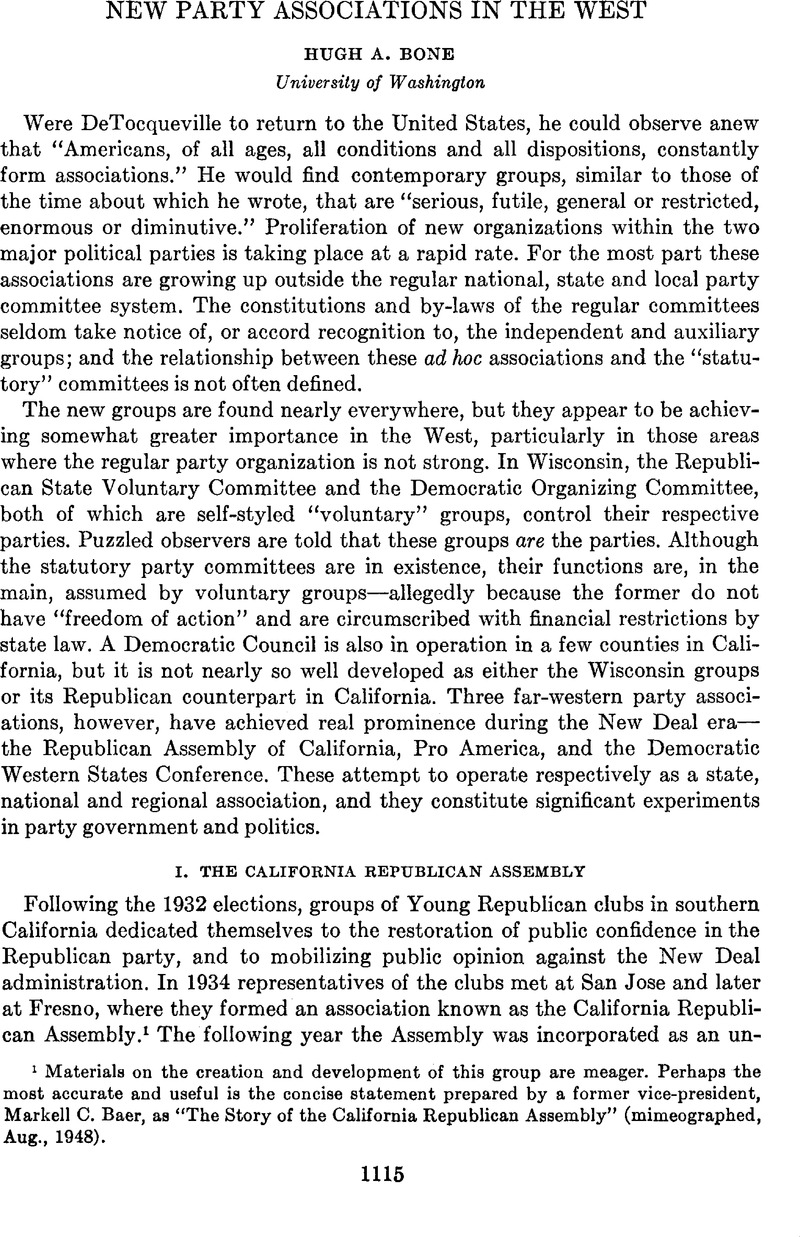No CrossRef data available.
Published online by Cambridge University Press: 02 September 2013

1 Materials on the creation and development of this group are meager. Perhaps the most accurate and useful is the concise statement prepared by a former vice-president, Baer, Markell C., as “The Story of the California Republican Assembly” (mimeographed, Aug., 1948)Google Scholar.
2 See Articles of Incorporation, California Republican Assembly, 1935.
3 See the Code of By-Laws of the California Republican Assembly, Article III. The by-laws are extremely elaborate.
4 Organization, on the whole, has developed most rapidly in the urban counties. Actual total state membership ia estimated as 7,000 paid-up members, with over half residing in Los Angeles County. At least as many additional persons appear to be actively connected with the Assembly, according to one official, but either have not been reported or have not paid their dues. Baer writes that membership in the Assembly is limited to “American citizens of good moral character, who are registered with the Republican Party, and who are accepted as members by their local organization” (“The Story of the California Republican Assembly,” p. 1).
5 The assemblyman was under indictment for assertedly accepting a bribe from a pension promoter. See San Francisco Chronicle, March 27, 1950.
6 The Committee is composed of one member of the organization from each congressional district and six members at large, chosen by the state board.
7 Letter to the writer from a former chairman of a Candidates and Fact-Finding Committee.
8 It might be noted that several weeks after the 1950 Assembly meeting, the Republican State Central Committee sponsored what it called the “first statewide Republican pow-wow of its kind” at Fresno. Some 1500 party leaders gathered to hear speeches by all nominees. The meeting, however, carefully refrained from making endorsements and adopting resolutions. For accounts of the meeting see the San Francisco Chronicle, April 22 and April 24, 1950.
9 National Association of Pro America, Manual on Organization (Yakima, Wash., 1950), p. 2Google Scholar.
10 Mrs. Roosevelt suggested the name as meaning “for the American system of government.” She held the title of national Honorary President.
11 In retrospect, these fears appear to have been highly exaggerated. For an excellent account of the political ferment surrounding the League, see Hillman, Arthur, The Un-employed Citizens' League of Seattle (Seattle, 1934)Google Scholar.
12 Manual on Organization, p. 3.
13 The national headquarters is in Yakima, Washington. Pro America units are organized on the basis of cities and counties; each state having units also elects a state president and perfects a token state organization. Pro America units are found in all of the larger cities and counties in California and Washington, and in a considerable number of the small ones.
14 Although Pro America and the California Republican Assembly were formed at about the same time with the common objective of revitalizing the party, it is interesting to note that the orientation of the former was essentially conservative, while the latter was center to Ieft-of-center in outlook.
15 See “Resolutions—Pro America,” adopted June 27, 1949, and May 5, 1950.
16 At times, of course, county and state central committees take a position on certain initiative and referendum propositions; Pro America commonly takes a position on every proposition on the ballot.
17 The chairman of the Republican meeting in Chicago in October, 1949, for example, stated that the conference had nothing to do with policy.
18 A news release by the Republican National Committee, February 6, 1950, promised such a report.
19 Letter to the writer.
20 The present chairman is Calvin W. Rawlings of Salt Lake City, who is Democratic National Committeeman for Utah.
21 The governing board of the Midwest Democratic Conference consists of the national committeemen and state chairmen and vice-chairmen from the thirteen states included in the conference.
22 A comprehensive summary of the statement and of several of the speeches will be found in The Democratic Digest, Vol. 26, pp. 15–18 (Oct.–Nov., 1949)Google Scholar. Other extensive accounts of the proceedings will be found in the San Francisco Chronicle, September 17, 18, 19, 20 and 21, 1949, and in the New York Times, September 19, 1949.
23 At the Denver meeting, resolutions were adopted vigorously supporting President Truman's foreign policies and “affirming the constitutional authority of our civilian government over the military.” In addition to this statement, the midwest and western groups adopted separate resolutions of special concern to their own areas. Transcripts of all panel discussions were made available shortly before adjournment. For a summary account, see the New York Times, May 27, 1951.
24 New York Times, September 19, 1949. It may be noted that this Conference suggests a partial answer to the recommendation of the Committee on Political Parties of the American Political Science Association “that the local party organizations should be imbued with a stronger sense of loyalty to the entire party organization and feel their responsibility for promoting the broader policies of the party.” “Toward a More Responsible Two-Party System,” American Political Science Review, Supplement, Vol. 44, p. 47 (Sept., 1950)CrossRefGoogle Scholar.
25 Letter to the writer.
Comments
No Comments have been published for this article.